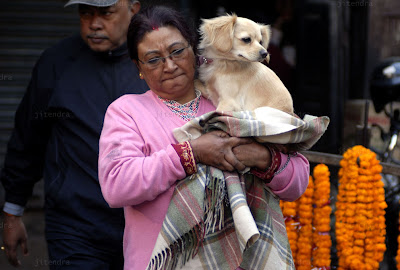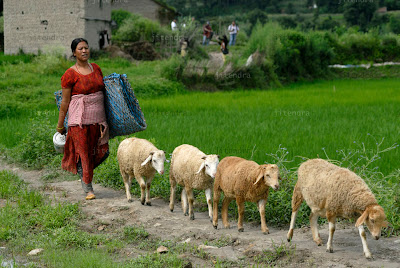Tuesday, January 24, 2012
Thursday, January 19, 2012
Wednesday, January 18, 2012
Changing Landmarks
Big commercial buildings are increasing in the capital and landscape is rapidly being dominated and dwarfed by big constructions as seen in these photos taken on Wednesday Jan 18,2012.The number of housings and apartments have immensely increased these days due to the increasing number of population at kathmandu valley.
Tuesday, January 17, 2012
Monday, January 16, 2012
Sunday, January 15, 2012
Women and Paddy Field of Khokana
Hardworking women farmers from Khokana village, Lalitpur heading for their paddy field to work. The month of June in Nepal is season of planting paddy, followed by mid September to October as harvesting time. Agriculture is the major sector of Nepalese economy. It provides employment opportunities to 66 per cent of the total population and contributes about 36 per cent in the GDP.
Location:
Khokana, Nepal
Friday, January 13, 2012
Thursday, January 12, 2012
Ghee Lamp for Annapurna
Light always signify knowledge and lighting ghee lamps can be more than just spreading knowledge if you have big faith in God. Many people light the lamp and bow down to knowledge as the greatest of all forms of wealth. Knowledge backs all our actions whether good or bad. People therefore keep a lamp lit during all auspicious occasions as a witness to thoughts and actions they take in life. I still remember my childhood days when my mother use to tell me that to offer a ghee lamp to God, is almost like burning yourself as a greatest offer to God.
Besides the traditional ghee and oil lamp has a further spiritual significance. The oil or ghee in the lamp symbolizes our vaasanas or negative tendencies and the wicked, the ego. When lit by spiritual knowledge, the vaasanas get slowly exhausted and the ego too finally perishes. The flame of a lamp always burns upwards. Similarly we should acquire such knowledge as to take us towards higher ideals.
Here's some devotees both from Buddhist and Hindu religion offering Ghee Lamps to Annapurna Ajima at Ason, Kathmandu in early morning.
Besides the traditional ghee and oil lamp has a further spiritual significance. The oil or ghee in the lamp symbolizes our vaasanas or negative tendencies and the wicked, the ego. When lit by spiritual knowledge, the vaasanas get slowly exhausted and the ego too finally perishes. The flame of a lamp always burns upwards. Similarly we should acquire such knowledge as to take us towards higher ideals.
Here's some devotees both from Buddhist and Hindu religion offering Ghee Lamps to Annapurna Ajima at Ason, Kathmandu in early morning.
Wednesday, January 11, 2012
Water Woes in Lalitpur.
People in core Patan city rely heavily on traditional water spouts like wells built
more than a century ago as they serve as the best source of water during the dry season.
Senior citizens of Lalitpur still recall, “No water from other source is tastier like
well water”.
The well water is widely used in various household purposes, ranging from washing to cleaning and sometimes drinking as well. Tradition and cultural linked with wells still survive in this historic city and people here still celebrate Cithinakha festival, during which they clean wells and preserve them. Lalitpur is probably the only place left where the locals have managed to restore and conserve the historic wells.
But the problems do exist, as the constantly decreasing water level indicates serious water crisis in the near future. Well water level does not remain constant but changes over the certain time period. As people are drawing more water, water level too has decreased in the wells. As a result, adding of the extra rings in the already existing wells has become a regular community activity nowadays. But this does seems to be the solution. Occasional practice of rain water harvesting and other conservational acts are delaying the “Going deeper in search of water process” slightly. It is now high time people in Patan work towards fi nding better ways to save these traditional heritage.
The well water is widely used in various household purposes, ranging from washing to cleaning and sometimes drinking as well. Tradition and cultural linked with wells still survive in this historic city and people here still celebrate Cithinakha festival, during which they clean wells and preserve them. Lalitpur is probably the only place left where the locals have managed to restore and conserve the historic wells.
But the problems do exist, as the constantly decreasing water level indicates serious water crisis in the near future. Well water level does not remain constant but changes over the certain time period. As people are drawing more water, water level too has decreased in the wells. As a result, adding of the extra rings in the already existing wells has become a regular community activity nowadays. But this does seems to be the solution. Occasional practice of rain water harvesting and other conservational acts are delaying the “Going deeper in search of water process” slightly. It is now high time people in Patan work towards fi nding better ways to save these traditional heritage.
Location:
Patan, Nepal
Tuesday, January 10, 2012
Walking Shadows
Photos that I have captured one evening at Ason for photo assignment during Frederic Lexloux from Agence VU, France photography workshop 'Photographing The Everyday' organized by photocircle. It was fun and poetic moments chasing shadows for hours under street lamp at Ason that day. I know shadows fascinate many photographers while other may find them scary.
Monday, January 09, 2012
Sunday, January 08, 2012
Friday, January 06, 2012
Yomari: Delightful Newar Delicacy
Yomari is the traditional food of Newar community in Nepal. I am not a big fan of Yomari but there are many people whose mouths get watery while they think of it. Yomari is a Newari delicacy which is made of rice flour stuffed with sweet paste made of molasses and sesame. Every year during the full moon of December Newar community around the valley celebrated festival Yomaripune, and this delicacy is get cooked.
Location:
Dilli Bazaar Rd, Kathmandu 44600, Nepal
Thursday, January 05, 2012
Subscribe to:
Comments (Atom)
Popular Posts
-
I've no idea why people lit these ghee lamps but I enjoy helping them to lit and offer it to Ajima in this Annapurna temple at Ason. M...
-
It was a cold rainy morning and I got little wet while coming to my office. So I tried to make myself warm sipping black tea and reading new...
-
Cascade of claps and cheers from the crowd crowned me not less than Lance Armstrong in winning Tour de France when I wheeled the finish li...
-
I am not sure why these house sparrows are brawling. May be it is survival tactic as saying goes, 'Survival of the fittest'. Interes...
-
Thuli Tamang 48yrs from Dashinkali sell Laligurans at Ason, Kathmandu on Sunday morning. 3 February 2013. She earns 400 hundreds, rupees sel...
-
Fancifully, I woke up in a strange bedroom and it didn't take long for me to realize that I was in a luxurious accommodation of Himalaya...






















































